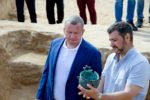 A farmer stumbled on a rare Sarmatian burial while working his land near the village of Nikolskoye in the Astrakhan region of southern Russia this winter. Rustam Mudayev was digging a pit when his bulldozer made an unusual sound. It was the sound of a mechanical digger meeting an ancient bronze pot. He took the vessel to the Astrakhan Museum-Reserve for examination and it was identified as Iron Age artifact.
A farmer stumbled on a rare Sarmatian burial while working his land near the village of Nikolskoye in the Astrakhan region of southern Russia this winter. Rustam Mudayev was digging a pit when his bulldozer made an unusual sound. It was the sound of a mechanical digger meeting an ancient bronze pot. He took the vessel to the Astrakhan Museum-Reserve for examination and it was identified as Iron Age artifact.
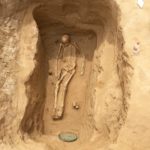 When the snow melted, a team of archaeologists surveyed the find site. The discovered that the bronze pot had emerged from an ancient burial mound. The mound is noted on topographic maps, labeled “Praying Sands,” but had not been archaeologically excavated before. Digging into the mound the team discovered the remains of an adult male buried with weapons, rich adornments and the head of his horse.
When the snow melted, a team of archaeologists surveyed the find site. The discovered that the bronze pot had emerged from an ancient burial mound. The mound is noted on topographic maps, labeled “Praying Sands,” but had not been archaeologically excavated before. Digging into the mound the team discovered the remains of an adult male buried with weapons, rich adornments and the head of his horse.
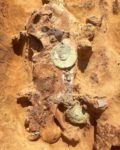 He was tall, just under six feet, and elderly. He had been buried in a closed coffin, his horse’s head in a silver and bronze harness placed on top of it. Inside the coffin archaeologists found a group of gold plaques that are believed to have decorated a pillow on which his head was resting. They also found knives with gold and turquoise decoration, a gold and turquoise belt buckle, a mirror and several pots. A tiny but exquisite gold and turquoise horse head figurine was found between his legs. The objects date to around the 2nd century A.D.
He was tall, just under six feet, and elderly. He had been buried in a closed coffin, his horse’s head in a silver and bronze harness placed on top of it. Inside the coffin archaeologists found a group of gold plaques that are believed to have decorated a pillow on which his head was resting. They also found knives with gold and turquoise decoration, a gold and turquoise belt buckle, a mirror and several pots. A tiny but exquisite gold and turquoise horse head figurine was found between his legs. The objects date to around the 2nd century A.D.
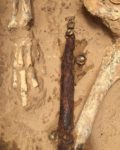 This was an elaborate burial for a nomadic people, an indication of the high status this individual held in his community. The weapons and the horse burial would have been reserved for a warrior and the wealth of the grave goods suggest he was a leader, a chieftain or nobleman.
This was an elaborate burial for a nomadic people, an indication of the high status this individual held in his community. The weapons and the horse burial would have been reserved for a warrior and the wealth of the grave goods suggest he was a leader, a chieftain or nobleman.
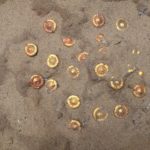 Initially the mound was dated to the Iron Age (4th century B.C. – 4th century A.D.) based on the artifacts, but additional discoveries point to the mound having been used repeatedly starting in the Bronze Age. The team has been digging for less than two weeks and they’ve found two more burials — a woman buried with a bronze mirror and a whole sacrificed lamb and the skeletal remains
Initially the mound was dated to the Iron Age (4th century B.C. – 4th century A.D.) based on the artifacts, but additional discoveries point to the mound having been used repeatedly starting in the Bronze Age. The team has been digging for less than two weeks and they’ve found two more burials — a woman buried with a bronze mirror and a whole sacrificed lamb and the skeletal remains 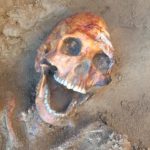 of a young man with an egg-shaped skull. Deliberate cranial deformation was a common practice in the region at the time (actually in pretty much every inhabited region on the globe at various times).
of a young man with an egg-shaped skull. Deliberate cranial deformation was a common practice in the region at the time (actually in pretty much every inhabited region on the globe at various times).
The mound has been looted in the past, but thankfully the looters did a shoddy job of it, only digging up the top Iron Age layer and not even clearing everything out. Archaeologists 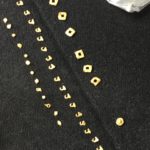 found small pieces of gold fittings or plaques left behind by the tomb raiders. They haven’t gotten to the central burial yet and excavations will continue for another week in the hopes they will reach the original Bronze Age burial that could date back to the third millennium B.C. Once the project is complete, the artifacts will be recovered, conserved and exhibited at the museum.
found small pieces of gold fittings or plaques left behind by the tomb raiders. They haven’t gotten to the central burial yet and excavations will continue for another week in the hopes they will reach the original Bronze Age burial that could date back to the third millennium B.C. Once the project is complete, the artifacts will be recovered, conserved and exhibited at the museum.